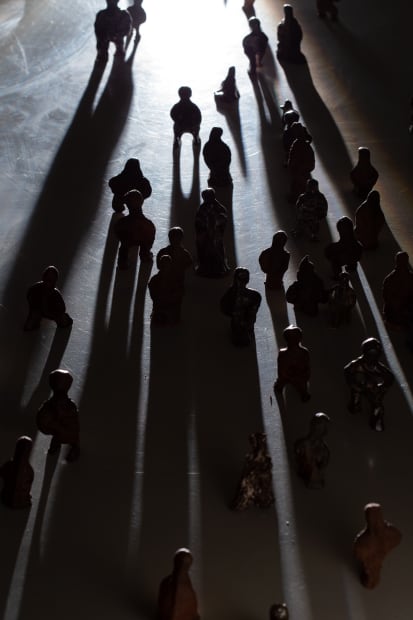-

-
Monument of Remembrance — is a solo exhibition by Mayana Nasybullova. The artist continues the exploration of the issues concerning the representation of traumatic experiences and historical memory. The narrative of the project is based around the central piece — Monument of Remembrance — Mayana rethinks the heritage of Soviet monumental art through the sculptural reflection on the total grief. Referring to the сomposition of the memorial ensemble as a traditional symbol and source of historical memory, the artist transforms its main elements, preserving the characteristic and recognizable aesthetic of monumentalism. The figures of mourners instead of warriors immortalized in stone and a well filled with tears instead of a triumphant eternal flame.
-
The project's exposition immerses viewers into an abandoned and ruined space. The installation Exodus, on the gallery first floor, consists of ceramic sculptures — a passing multitude, frozen in the process of disappearance, migration and escape. It no longer represents people, but ghosts whose traces still retain memories of what happened. But where people fade, only silent witnesses remain: half-destroyed and irrelevant monuments — the bearers of the past that no one remembers.
The project is a logical continuation of the two-part installation ‘Everything is terrible’, shown this summer at the Vadim Sidur Museum in Moscow, which is devoted to the study of the phenomenon of catastrophe as a recurrent process that destroys the global history of civilization.
-

-
-
-
Perhaps memory was designed to remember a traumatic experience and never repeat it again. Although there are few left who truly remember. They disappear, fade, leave, and come to an end. Like the multitude of Mayana’s ceramic figurines, frozen in the process of exodus. The experience of human civilization shows us how the state produces artificial patterns of commemoration — it silences reality, leaving memories on the sidelines of history, or it invents new ones. But there is one important thing: No one chooses whether or not to remember trauma. It cannot be forgotten. It doesn't go away. It remains inside all of us, and there is not any form of oblivion to undo it. This is a kind of ‘dark memory', because no matter how far one buries it in the depths of the collective unconscious, it still affects our present, and even shapes it.
Ilya Kronchev-Ivanov
Art Historian and Researcher of Anna Nova Gallery
-

MONUMENT OF REMEMBRANCE: MAYANA NASYBULLOVA
Past viewing_room




